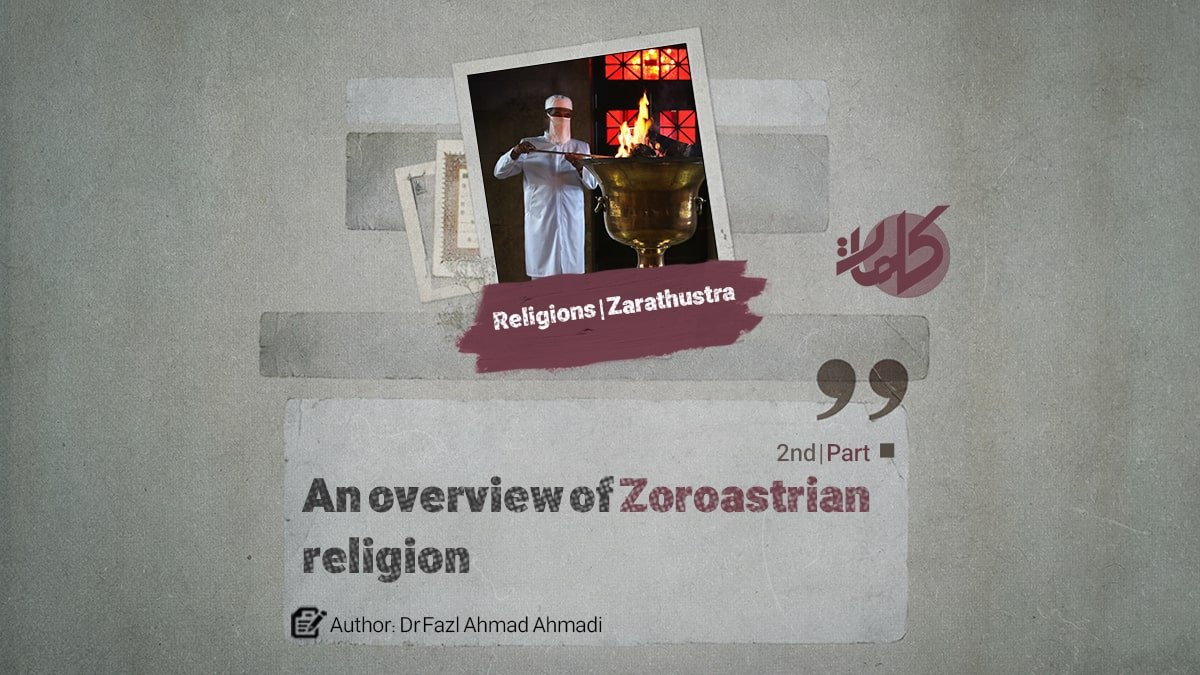
Author: Dr. Fazl Ahmad Ahmadi
An overview of Zoroastrian religion (Part 2)
1- Zoroastrian religion
One of the living religions of the world is Zoroastrianism, which originated in Iran. According to the narratives, Zoroaster was born in 975 BC, and according to various and mostly Iranian narratives, Zoroaster introduced the new religion to the king in the 30th year of the “Goshtasb” reign. Zarathustra was 42 years old at this time and was killed in the year (898 BC) at the age of 77 during the attack of Arjasb Turani’s army in the fire temple of Balkh. Of course, there is no agreement among thinkers and researchers about the year of birth, death and longevity of Zoroaster; rather, each of the researchers has reached different results in their writings, which is difficult to collect among them.
Anyway, they say, is the original name of Zoroaster as stated in the “Ghats”: “Zarathustra” means the owner of a yellow camel. Naming in ancient times was mostly based on people’s way of life. “In the herding society three thousand years ago, where cattle and herds were the biggest assets, most of their names were the names of the main animals in the lives of the people of Khwarezm and Bactria, the birthplace of the Zoroastrian people, and these elements were used in the composition of the names of these people a lot”. Of course, this feature was not unique to the people of Zoroastrian ‘s hometown; Rather, such descriptions and names are abundantly seen in the literature of pre-Islamic ignorance among Arabs.
The family in which Zoroaster grew up is called “Sapitmeh”. His father’s name was “Purushespe”, and his mother’s name was “Doghdova”. Zarathustra has learned religious teachings since childhood; because in “Gahan” (Yasan, 33, paragraph 6) he called himself “Zotar” and it is a term that is used for the religion of the people who are in full spiritual conditions. And in the late Avesta (Yasht 13, paragraph 94) the word “Athrun” is also used, which has the absolute meaning of the spiritual and the religion of the people.
There is a strong difference of opinion about the character of Zoroaster among scholars and historians, some of them believe that Zoroaster is a prophet and messenger of Allah, while others say that Zoroaster was a disciple of a prophet named “Jeremiah” who later separated from him and invited him to a new religion. And another group knows Zoroaster only as a reformed person and even a group thinks that Zoroaster is a myth which is not true; and even some people are of the opinion that Zoroaster took religious teachings from the Abrahamic Hanafi and Hindu Brahmanical religions. And on the contrary, it has been proposed by some people, that is, that Judaism, Christianity and Islam have taken many teachings from Zoroastrian religion.
The Arabs were the first to call the followers of Zoroastrian Magus. The word Magus is attributed to the first tribe that followed Zoroaster and they were fire worshipers, or in other words, Magus is derived from the word “Magoos” which means priesthood or those who interpret dreams.
The religion of Zoroastrianism spread a lot in the early centuries, as many lands of Persia, India and some Arab regions were taken by the followers of Zoroastrianism, until Alexander the Great burned most of the Zoroastrian books.
It is said: Before Zoroaster in the land where he was born, there was a multitude of gods worshiped; But Zoroaster, who was born in a noble family, and after being chosen as a prophet by “Ahura Mazda”, invited people to worship the one God and declared all past beliefs and myths to be false (Said, Bita: 150). The only god of Zoroastrianism is called “Ahuramazda”. The word “Ahuramazda” is composed of two components. The first part is “Ahura” which means “head, chief, great, eunuch and gods” and the second part is “Mazda” which means “wise and aware of everything”. The word “Ahuramazda” means omniscient or great wise. Zoroastrian God is absolute light and has no resemblance to any tangible object and is intangible.
In other words, Zoroastrianism begins with Ahuramzad. In this ritual, Ahuramzad is the creator of good things and there is no place for evil in his threshold. He is a creator and does not know destruction. He creates good things from his existence. He is the gem and the giver of wisdom, truth and grace, peace and love, chosen power and Ahura’s ruler ship, reach and comprehensiveness and immortality. Man is created in the image (moral similitude) of Ahuramzda and is the holder of a ray of Ahura’s rays.
Also, the cause of all material and spiritual causes is the infinite absolute existence that is the cradle and main destination of the entire universe. Zarathustra calls this supreme power of all powers “Ahura Mazda” and in verse 31 of the seventh chapter of the Avesta, he says: “O Ahura Mazda, in my thinking power, I realized that you are the beginning, that you are the end, that you are the pure father, that you are the creator of truth, that you are the judge of the world’s actions. »
Zoroaster, the prophet of ancient Iran, was known as one of the greatest scientists and sages in the world outside of Iran, especially in ancient Greece and Rome, and he was mentioned in European writings as a scientist and researcher until 1771 AD. But in 1771 AD, for the first time, the book “Avesta” attributed to Zoroaster was translated into French by a French scientist named “Enkiel Duperon” and after that European and Western writer wrote many articles in this field and Zoroastrian’s religious status was also revealed in their writings.
The study of religions shows that Zoroastrian religion, although there is doubt about its heavenly and divine nature, has good characteristics in its era and time: it was monotheistic; Ahuramazda of this religion is the creator of beauty and goodness; has had good principles for reforming the individual and society, that is, “good thoughts, good words and good deeds”; had an optimistic philosophy, that is, in the end, it believed in the victory of truth and goodness over falsehood and evil, and drew a bright future for humanity; it was a lover of science and a follower of human originality; observed cleanliness; believed in human free will and rejected predestination and fatalism; wanted people to be equal and free; adhered to justice; had great respect for nature and its elements; respected women’s rights strangely in that era and believed in monogamy. The most interesting thing is that the religion of Zoroastrianism was a religion of joy and celebration.
Zoroaster asks “Ahuramazda” (his god) to help him on the way to his goal. Throughout the “Ghats”, the Prophet of Iran prays “Ahura Mazda” and considers him the creator of the whole and the possessor and manager of the universe; For example, in the first part of “Gathas”, part 28-1, Zoroaster asks for favor from “Ahura Mazda” and says the following words: “Praising the holy wisdom of Mazda, you raise your hands to ask for help, you ask me first of all.” I will please Esha and Homan (good thoughts) and the soul of creation”.
One of the most basic concepts in Zoroastrianism (Ayinbehi) is the concept of “Ashe”. As mentioned, in Gahan, Ahuramzada occupies the top position. He is good and holy and created the world with thought. On the side of “Ahuramzada”, there are a group of other Minoan beings called Amshasepandan, which include: Ashe, vahumna (good thought), Armiti (pious), Kheshetra (power), Heurotat (perfection) and Amrtat (immortality).
In other words, one of the most important and essential among these “Amshasepandan”, as mentioned, is “Ashe”. Ashe is one of the key and basic concepts in Zoroastrian wisdom and in fact the “metaphysical” law of the order of two worlds. There is no word or term that can define this concept. Ashe uses religiosity, justice, virtue and some other moral concepts in the same way. According to some writers, including Fethullah Mojtabaei, “in the opinion of the Aryans, Iran and India [ashe] meant the order and ritual that connects the entire world of existence, and over all affairs, general and partial, and over all objects.
The small and large has been the ruler, and the general order of the world in the big cosmos and in the small human world (which is imagined as a diagram of the great cosmos), the natural order, the social system, the moral system, and the system of religious rituals are all its manifestations in different worlds. In the opinion of Iranians, truth (Arsta), whose meaning is closer to “justice” than “right speech”, is to harmonize with the moral and social system, and to break and disrupt this ritual by oppression and falsehood. In fact, Ashe should be considered “the moral system governing the universe and the eternal honor of nature” without which the order of the natural world would be disrupted.
According to Zoroaster’s “Asho/Esha” teachings, the center of the universe and the origin of all beings is “Ahuramzada” who is omnipotent. Zarathustra guides his followers to the right path and tells them that: “There is only one way in the world and that is the right way” (Tarapuran, Bita: 880).
To put it simply, in Ashe’s world order, everyone should be in their place; it means that everyone has a specific and unique place and position that should be settled in the same place and dignity. The basis of the definition of justice as everything being placed in its place (وضع الشئ علی مکانه) is exactly here.
After getting to know Ashe and understanding it, man has the duty to apply the content and requirements of such a cosmic order in his life and always follow this order, and the famous three commands of Zoroaster (good thoughts, good speech and good deeds) are also in this straight. The followers of such a ritual and order are called Ashvan or followers of Ash and truth, and they are always in front of the followers of lies (Dregvant). Therefore, ash is the manifestation and symbol of the metaphysical order and course of life on Earth in Zoroastrianism.
Many thinkers have written and spoken about Zoroastrian religion, in ancient Greece, “Plato”, who lived several centuries after Zoroastrian, considered Zoroastrian as the founder of the religion and called this religion the best way to praise God and have great thoughts. Aristotle and a number of other ancient Greek thinkers also have statements in this field, which are omitted from mention…
Continues…



